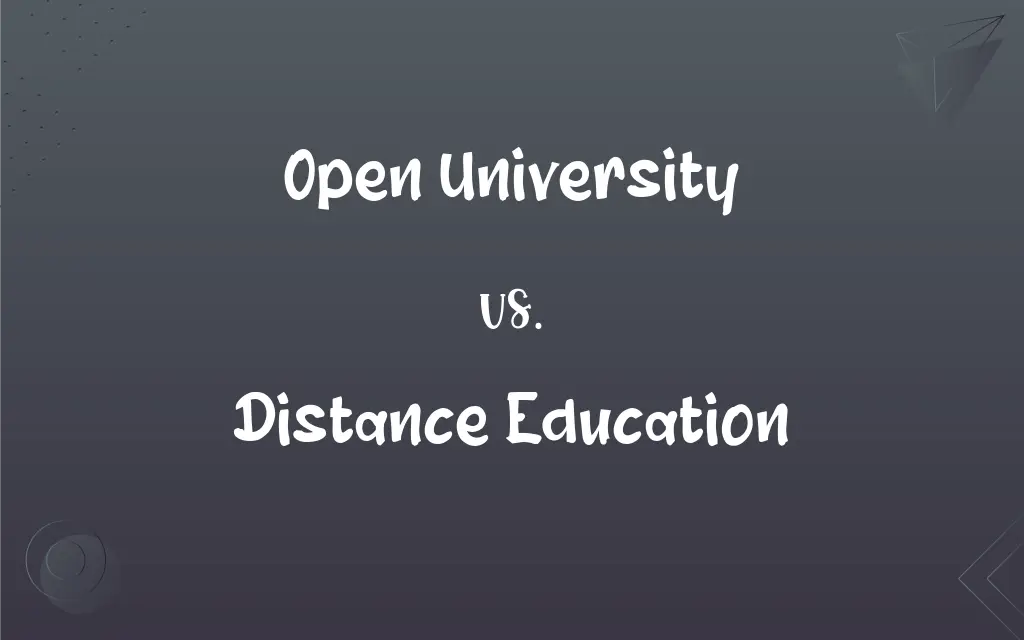Open University vs. Distance Education: What's the Difference?
Edited by Aimie Carlson || By Harlon Moss || Updated on October 9, 2023
Open University is a specific or general term for universities providing flexible learning paths, often via distance learning. Distance education is a method of studying where teaching is conducted without in-person interaction.

Key Differences
Open University, as the terminology hints, extends an "open" approach towards education, where age, qualifications, and geographical boundaries do not restrict learning. In contrast, distance education is a mode of delivering education and instruction, often on an individual basis, to students who are not physically present in a traditional location such as a classroom.
The concept of an open university hinges on inclusivity, often providing courses to individuals regardless of their educational background or age, embodying a philosophy of eliminating barriers to education. On the flip side, distance education, while inclusive, primarily centers around the delivery method, facilitating learning through various modes, such as online courses, without mandating physical presence.
While open universities tend to leverage distance education mechanisms, employing technology to facilitate learning far and wide, the latter is not exclusive to universities and can be adopted by various educational institutions. Distance education, therefore, may not always uphold the open enrollment and inclusive philosophy that is pivotal to open universities.
Open University is a distinct institution that employs a multitude of strategies, including distance education, to provide accessible learning. It emphasizes individualized study, providing opportunities that might be unavailable through traditional formats. Meanwhile, distance education is versatile and can be employed by various educational institutions, not solely open universities, to cater to remote students, offering a structured learning experience without the need for physical attendance.
In essence, open university and distance education, while overlapping in some aspects, diverge in their fundamental philosophy and application. The former is an institution, or type thereof, with an ethos rooted in accessible and flexible education. Meanwhile, the latter is a mode of delivering education, which can be utilized by diverse educational entities, including open universities, to facilitate remote learning.
ADVERTISEMENT
Comparison Chart
Definition
A type of university that provides flexible learning opportunities often through distance education.
A method of teaching where students and instructors are not in the same location.
Inclusivity
Typically very inclusive, admitting students regardless of previous academic performance or age.
Can be utilized by both inclusive and exclusive educational institutions.
Philosophy
Aims to remove barriers to education, offering numerous, varied learning paths.
Focuses on the delivery method and can be implemented by various types of institutions.
Application
Often employs distance education but is not restricted to it.
A mode of delivery, not a type of institution, and can be used by open universities.
Example
The Open University in the UK.
Online courses offered by Harvard University through various platforms.
ADVERTISEMENT
Open University and Distance Education Definitions
Open University
A university system that uses multiple platforms to deliver education to students regardless of their location.
Open University students can study from any location with internet access.
Distance Education
A learning model where students and instructors interact in a non-traditional, non-face-to-face manner.
Through distance education, learners can access high-quality instruction remotely.
Open University
An educational institution emphasizing open access to courses and resources, typically through distance learning mechanisms.
John, a full-time worker, enrolled in an Open University program to pursue higher education without attending traditional classes.
Distance Education
An educational structure providing learning opportunities without requiring physical presence in a classroom.
Many professionals opt for distance education to enhance their skills without disrupting their careers.
Open University
An institution that provides varied courses and degree programs without formal academic entry requirements.
The Open University in the UK offers numerous courses without necessitating prior qualifications.
Distance Education
Educational instruction and content delivered via technological platforms to remote students.
Distance education allowed Jake to complete courses at his own pace.
Open University
A structured system providing higher education and specialized courses using flexible learning methodologies.
The Open University enabled Maria to earn her degree while traveling the world.
Distance Education
A system where educational materials are transmitted to geographically dispersed learners.
Online learning platforms have made distance education more accessible and interactive.
Open University
A university model that endeavors to eliminate barriers to education, such as age, qualification, and geography.
The Open University enables retirees to pursue new learning journeys without commuting to a campus.
Distance Education
A method of instruction and learning where participants are geographically separated.
Sarah completed her master's through distance education while living abroad.
FAQs
How does Distance Education work?
Distance Education involves delivering educational content remotely, using various technologies to facilitate learning without in-person interaction.
Can Distance Education be considered an Open University?
No, Distance Education is a method of delivering content remotely, while an Open University is an institution with a philosophy of inclusive, accessible education.
Can Distance Education provide practical or lab-based learning?
It can be challenging, but some Distance Education courses offer virtual labs, simulations, or in-person lab sessions.
Can Distance Education cater to full-time and part-time students?
Yes, Distance Education can be designed to accommodate both full-time and part-time learning schedules.
How do students interact with instructors in Distance Education?
Interaction can happen via various online platforms, including forums, email, video conferencing, and virtual classrooms.
Are all courses at an Open University delivered through distance learning?
Often, yes. Open Universities typically leverage distance learning, but they might also offer in-person courses or blended learning.
Are Open Universities available globally?
Yes, there are Open Universities and similar institutions providing flexible learning paths in numerous countries worldwide.
How does one enroll in an Open University?
Enrollment processes vary, but typically involve online application through the university’s website without stringent admission requirements.
How technologically adept do students need to be for Distance Education?
Basic technology skills and access to a computer and the internet are typically required for Distance Education.
Can international students enroll in an Open University?
Yes, Open Universities often allow international students to enroll in courses and degree programs.
Are Open Universities accredited?
Yes, many Open Universities are accredited and offer recognized degrees and qualifications.
Is age a barrier to enrollment in Distance Education programs?
No, Distance Education is accessible to individuals of all ages, providing lifelong learning opportunities.
Can one transfer credits from an Open University to a traditional university?
Yes, credit transfer is possible, though it depends on the universities and programs involved.
What is an Open University?
An Open University provides accessible and flexible higher education opportunities, often using distance education, without strict admission criteria.
Is Distance Education only for degree programs?
No, Distance Education can be utilized for various educational purposes, including degrees, diplomas, certificates, and short courses.
How is the examination process conducted in Distance Education?
Examinations in Distance Education might be conducted online, at designated test centers, or through other approved methods.
Do Open Universities offer financial aid or scholarships?
Yes, many Open Universities offer various forms of financial aid, scholarships, or payment plans.
Is Open University suitable for postgraduate studies?
Yes, Open Universities often provide a range of postgraduate options including Master's and Doctoral programs.
Can Distance Education be utilized for vocational training?
Yes, Distance Education can be employed for a variety of educational and training purposes, including vocational training.
Does Open University education have the same value as traditional university education?
Yes, often degrees from accredited Open Universities are equivalent in value to those from traditional universities.
About Author
Written by
Harlon MossHarlon is a seasoned quality moderator and accomplished content writer for Difference Wiki. An alumnus of the prestigious University of California, he earned his degree in Computer Science. Leveraging his academic background, Harlon brings a meticulous and informed perspective to his work, ensuring content accuracy and excellence.
Edited by
Aimie CarlsonAimie Carlson, holding a master's degree in English literature, is a fervent English language enthusiast. She lends her writing talents to Difference Wiki, a prominent website that specializes in comparisons, offering readers insightful analyses that both captivate and inform.
































































